This postcard includes two of the most important islands in Korea, traditional Korean clothing (Hanbok), Korean food, Korean holidays, the Korean alphabet, and lastly traditional Korean paper.
Through this postcard you can learn about Korean history, food, and people all in one place. You can also download this postcard and share with your friends the diversity and depth of the Korean culture!
Together let’s share our countries uniqueness through this cultural postcard!
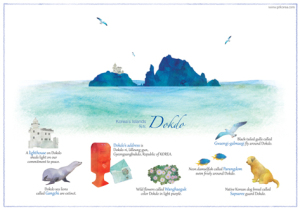 Dokdo, Korea’s Eastern Island
Dokdo, Korea’s Eastern Island
Dokdo is Korea’s easternmost volcanic island that consists of two main islands. In 1905, Dokdo became the first Korean territory to be affected by Japan’s imperialism. Today, Dokdo strengthens our will to protect peace and freedom by reminding us of Korea’s history. This postcard also has some of unique animals found on Dokdo’s and other unique traits on the island.
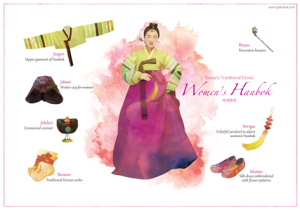 Korean Traditional Dress – Women’s Hanbok
Korean Traditional Dress – Women’s Hanbok
Hanbok is Korea’s traditional dress. When the Hanbok is worn, the multiple folds of fabric create an elegant volume which is comfortable for all body types. Because of its loose fit Hanbok is suitable for traditional Korean lifestyle, which is sitting on the floor. Women’s Hanbok consists of a long-sleeve top and a voluminous skirt with a underskirt and trousers underneath. Depending on a person’s social status and occasions, Hanbok was adorned with various accessories, such as a hairpin, a coronet, and a pendant.
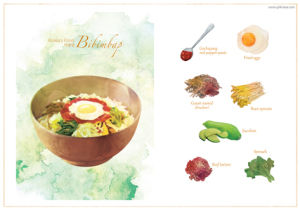 Korea’s Food – Bibimbap
Korea’s Food – Bibimbap
Bibimbap is one of Korea’s most popular dishes, and has begun to be recognized globally. Bibimbap is made by mixing rice with an egg, red pepper paste, and assorted vegetables. Depending on the region and the ingredients, there is a wide variety of Bibimbap in Korea. In this food postcard you can see some of the ingredients that go into making Bibimbap.
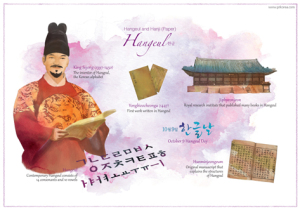 Hanguel
Hanguel
Hanguel is the native Korean alphabet invented by King Sejong (1397-1450) in 1443 during the Joseon Dynasty (1392-1910). During the time King Sejong invented Hanguel, it was called “Humminjeongeum” which means proper sounds to instruct the people. Hundreds of years later the purpose and principles of invention are still explicitly known to us since the Hunminjeongeum manuscript was published with a commentary. The manuscript is even listed on UNESCO’s Memory of the World Register. King Sejong created Hanguel for the common people who could not afford to learn the difficult Chinese characters used by the nobles. Now, Korea has the lowest illiteracy rate in the world due to simplicity of Hanguel.
 The possibilities of a reunified Korea are endless. Not only will there be peace within east Asia, economic development between countries will also proper. The once isolated Korea will have opportunities to create trade with nearby regions and also develop their industrialization. Also, instead of using its military to protect and fight itself, a reunified Korea will be able to distribute their military power towards peace in other countries with disputes still going on. These endless possibilities show that reunification is a feasible option for Korea because of the numerous benefits that Korea could gain through reunification. These possibilities are shown on the map like a feasible railroad that could connect Korea, China, Russia, and even Europe.
The possibilities of a reunified Korea are endless. Not only will there be peace within east Asia, economic development between countries will also proper. The once isolated Korea will have opportunities to create trade with nearby regions and also develop their industrialization. Also, instead of using its military to protect and fight itself, a reunified Korea will be able to distribute their military power towards peace in other countries with disputes still going on. These endless possibilities show that reunification is a feasible option for Korea because of the numerous benefits that Korea could gain through reunification. These possibilities are shown on the map like a feasible railroad that could connect Korea, China, Russia, and even Europe.
 How much do you know about astronomy? There were many great developments, inventions, and astronomers who have helped us to learn more about the stars and skies. One famous example is the astronomer Nicolaus Copernicus who helped to formulate the heliocentric model of the universe. In other words, Copernicus was the first person to create a model that proposed that the Sun, and not the Earth, was the center of the Solar System.
How much do you know about astronomy? There were many great developments, inventions, and astronomers who have helped us to learn more about the stars and skies. One famous example is the astronomer Nicolaus Copernicus who helped to formulate the heliocentric model of the universe. In other words, Copernicus was the first person to create a model that proposed that the Sun, and not the Earth, was the center of the Solar System.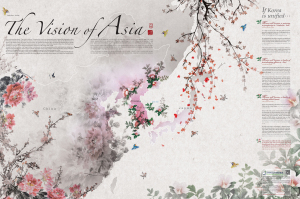 There is a phrase “The world is a flower” and it means the world is one inseparable entity. Korea represents Mugunghwa, China the plum blossom and the peony, and Japan represents cherry blossoms. These three flowers are different kinds of flowers with different colors, scents, and distinctions. However, if they were to be arranged in harmony, these three different flowers can become one beautiful flower garden. VANK’s dream is to create one peaceful flower garden that represents these three Northeast Asian countries. As one Asian continent we can bring more peace to the world.
There is a phrase “The world is a flower” and it means the world is one inseparable entity. Korea represents Mugunghwa, China the plum blossom and the peony, and Japan represents cherry blossoms. These three flowers are different kinds of flowers with different colors, scents, and distinctions. However, if they were to be arranged in harmony, these three different flowers can become one beautiful flower garden. VANK’s dream is to create one peaceful flower garden that represents these three Northeast Asian countries. As one Asian continent we can bring more peace to the world. Korea’s image in the world is not always seen in a positive light because of separation and ongoing tension. However, Korea has been divided only for 70 years of its 5,000 years of history. Our ancestors’ spirits as well as their cultural heritages built with hopes of positive change and prosperity are within Korea. Now, succeeding the spirits of the ancestors, we are doing our best to overcome the division of the country and to achieve our dream of positive changes and prosperity of the 21st century world. Reunification is not only about simply rejoining the Baekdudaegan (a mountain range that runs through the Korean peninsula) and reconnecting the railroads. It is also about reopening the Korean peninsula’s blocked energy flow. Freely spreading the dream and passion of Koreans, and this achieving the peace and prosperity of the world.
Korea’s image in the world is not always seen in a positive light because of separation and ongoing tension. However, Korea has been divided only for 70 years of its 5,000 years of history. Our ancestors’ spirits as well as their cultural heritages built with hopes of positive change and prosperity are within Korea. Now, succeeding the spirits of the ancestors, we are doing our best to overcome the division of the country and to achieve our dream of positive changes and prosperity of the 21st century world. Reunification is not only about simply rejoining the Baekdudaegan (a mountain range that runs through the Korean peninsula) and reconnecting the railroads. It is also about reopening the Korean peninsula’s blocked energy flow. Freely spreading the dream and passion of Koreans, and this achieving the peace and prosperity of the world.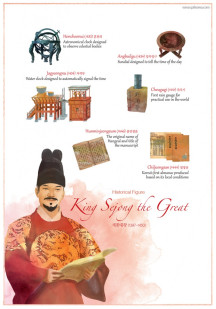 King Sejong the Great
King Sejong the Great 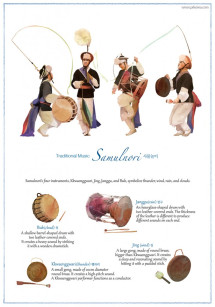 Traditional Music of Korea: Samulnori
Traditional Music of Korea: Samulnori Seoul Museum of History
Seoul Museum of History Changdeokgung Palace
Changdeokgung Palace War Memorial of Korea
War Memorial of Korea Dokdo, Korea’s Eastern Island
Dokdo, Korea’s Eastern Island Korean Traditional Dress – Women’s Hanbok
Korean Traditional Dress – Women’s Hanbok Korea’s Food – Bibimbap
Korea’s Food – Bibimbap Hanguel
Hanguel
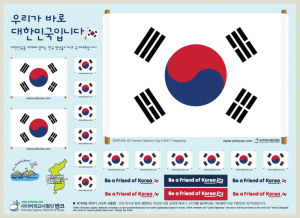 Taegeukgi is Korea’s national flag. It has a white background with a red and blue Taegeuk circle in the center and trigrams in all four corners. The Taegeuk circle represents harmony between yin (blue) and yang (red), reflecting the Korean people’s traditional belief that the creation and evolution of all things in the universe resulted from the interaction between yin and yang. The four trigrams stand for heaven, earth, water and fire.
Taegeukgi is Korea’s national flag. It has a white background with a red and blue Taegeuk circle in the center and trigrams in all four corners. The Taegeuk circle represents harmony between yin (blue) and yang (red), reflecting the Korean people’s traditional belief that the creation and evolution of all things in the universe resulted from the interaction between yin and yang. The four trigrams stand for heaven, earth, water and fire.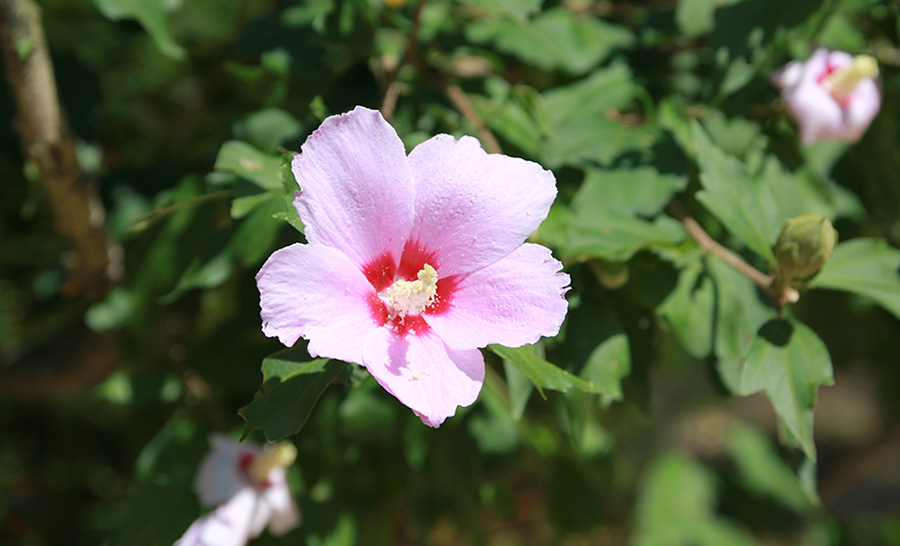 Mugunghwa is Korea’s national flower. It has been grown on the Korean peninsula for thousands of years. The Korean people have developed a special attachment to this flower, and Mugunghwa was naturally chosen to represent Korea. Mugung means eternity, which symbolizes the people’s patience and tenacity that enabled the nation to survive and prosper for 5000 years. Mugunghwa blossoms in various shades, such as white and pink, usually from July to October.
Mugunghwa is Korea’s national flower. It has been grown on the Korean peninsula for thousands of years. The Korean people have developed a special attachment to this flower, and Mugunghwa was naturally chosen to represent Korea. Mugung means eternity, which symbolizes the people’s patience and tenacity that enabled the nation to survive and prosper for 5000 years. Mugunghwa blossoms in various shades, such as white and pink, usually from July to October.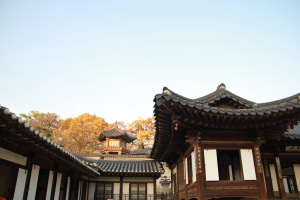 Korea’s traditional Hanok housing emphasizes harmony with nature. Hanok buildings were built of natural materials, such as wood, soil, and stone, with careful consideration not to damage the surrounding natural landscape.
Korea’s traditional Hanok housing emphasizes harmony with nature. Hanok buildings were built of natural materials, such as wood, soil, and stone, with careful consideration not to damage the surrounding natural landscape. VANK’s Hanguel stickers!
VANK’s Hanguel stickers!